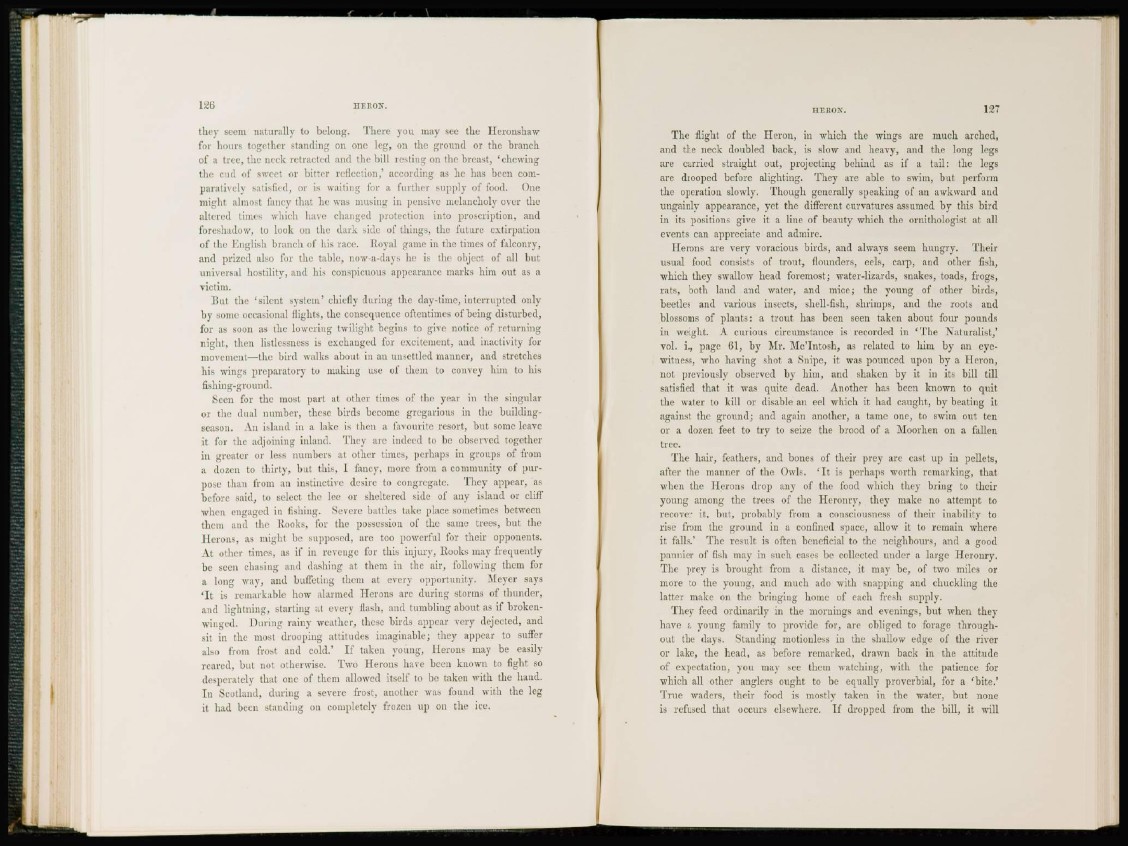
HERON.
they seem naturally to belong. There you may see the Hcronshaw
for hours together standing on one leg, on the ground or the branch
of a tree, the neck retracted and the bill resting on the breast, 'chewing
the cud of sweet or bitter reflection,' according as he has been comparatively
satisfied, or is waiting for a further supply of foot!. One
might almost fancy that he was musing in pensive melancholy over the
altered times which have changed protection into 2>roscription, and
foreshadow, to look on the dark side of things, (ho future extirpation
of the English branch of his race. Royal game in the times of falconrv,
and prized also for the table, now-a-days he is the object of all but
universal hostility, and his conspicuous appearance marks him out as a
victim.
loit the 'silent system' chiefly during the day-time, interrupted only
by some occasional flights, the consequence oftentimes of being disturbed,
for as soon as the lowering twilight begins to give notice of returning
night, then listlcssncss is exchanged for excitement, and inactivity for
movement—the bird walks about in au unsettled manner, and stretches
his wings preparatory to making use of them to convey him to his
fishing-ground.
Seen for the most part at other times of the year in the singular
or the dual number, these birds become gregarious in the buildingseason.
An island in a lake is then a favourite resort, but some leave
it for the adjoining inland. The) are indeed to be observed together
in greater or less numbers at other times, perhaps in groups of from
a dozen to thirty, but this, I fancy, more from a community of purpose
than from an instinctive desire to congregate. They appear, as
before said, to select the lee or sheltered side of any island or cliff
when engaged in fishing. Severe battles take place sometimes between
them and the Rooks, for the possession of the same trees, but the
Herons, as might be supposed, are too powerful for their opponents.
At other times, as if in revenge for this injury, Rooks may frequently
be seen chasing and (hushing at them in the air, following them for
a lung wav, and buffeting them at every opportunity. Meyer says
' I t is remarkable how alarmed Herons arc during storms of thunder,
and lightning, starting at every flash, and tumbling about as if brokenwinged.
During rainy weather, these birds appear very dejected, and
sit in the most drooping attitudes imaginable; they appear to suffer
also from frost and cold.' If taken young, Herons may be easily
reared, but not otherwise. Two Herons have been known to fight so
desperately that one of them allowed itself to be taken with the hand.
I n Scotland, during a severe frost, another was found with the leg
it had been standing on completely frozen up on the ice.
H E R O N . 1:27
The flight of the Heron, in which the wings are much arched,
and the neck doubled back, is slow and heavy, and the long legs
are carried straight out, projecting behind as if a tail: the legs
are drooped before alighting. They are able to swim, but perform
the operation slowly. Though generally speaking of an awkward and
ungainly appearance, yet the different curvatures assumed by this bird
in its positions give it a line of beauty which the ornithologist at all
events can appreciate and admire.
Herons are very voracious birds, and always seem hungry. Their
usual food consists of trout, flounders, eels, carp, and other fish,
which theyT swallow head foremost; water-lizards, snakes, toads, frogs,
rats, both land and water, and mice; the young of other birds,
beetles and various insects, shell-fish, shrimps, and the roots and
blossoms of plants: a trout has been seen taken about four pounds
in weight. A curious circumstance is recorded in ' T h e Naturalist,'
vol. i., page 61, by Mr. Mc'Intosh, as related to him by an eyewitness,
who having shot a Snipe, it was pounced upon by a Heron,
not previously observed by him, and shaken by it in its hill till
satisfied that it was quite dead. Another has been known to quit
the water to kill or disable an eel which it had caught, by beating it
against the ground; and again another, a tame one, to swim out ten
or a dozen feet to try to seize the brood of a Moorhen on a fallen
tree.
The hair, feathers, and bones of their prey arc cast up in pellets,
after the manner of the Owls. ' I t is perhaps worth remarking, that
when the Herons drop any of the food which they bring to their
young among the trees of the Heronry, they make no attempt to
recover it, but, probably from a consciousness of their inability to
rise from the ground in a confined space, allow it to remain where
it falls.' The result is often beneficial to the neighbours, and a good
pannier of fish may in such cases be collected under a large Heronry.
The prey is brought from a distance, it may be, of two miles or
more to the young, and much ado with snapping and chuckling the
latter make on the bringing home of each fresh supply.
They feed ordinarily in the mornings and evenings, but when they
have a young family to jn'ovide for, are obliged to forage throughout
the days. Standing motionless in the shallow edge of the river
or lake, the head, as before remarked, drawn back in the attitude
of expectation, you may see them watching, with the patience for
which all other anglers ought to be equally proverbial, for a 'bite.*
True waders, their food is mostly taken in the water, but none
is refused that occurs elsewhere. If dropped from the bill, it will